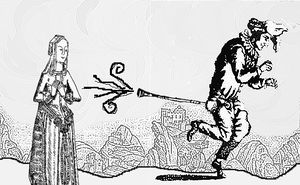Opoopaphone
The opoopaphone (Fr. èpeupapheun, Ger. œpüpafon, pl. opoopaphoneß) is a musical instrument of the woodwind family.
History[edit | edit source]
The opoopaphone was invented in 1672 CE by Parisian instrument manufacturer Auguste Poopa (b ca. 1600, d 1995). The instrument quickly became favored by princesses and soon every court had a consort of opoopaphoneß.
It is unknown the extent that the opoopaphone was used in Baroque instrumental ensembles. Scores do contain the abbreviation "Poop." but today these are generally transcribed for the contrabassoon or the faggot.
During the Classical Period, the opoopaphone became the favorite instrument of Mozart von Beethoven, who wrote the famous Pachelbel's Canon and Toccata. The pivotal Claire de lune by Scott Joplin signaled the instrument's entry into the orchestra.
It is widely believed that the opoopaphone was favored during the 19th century for its expressive, lyrical qualities. Oscar Wilde was to have said that the opoopaphone "most closely approximates the sound of the human voice." Famous 19th century composers to have used the opoopaphone in an orchestral setting include Schubert (in the Unfinished Symphony's 3rd movement), C.M. von Weber, Wagner (who's orchestration for Tristan und Isolde asks for a choir of 14 Wagner opoopaphoneß), and John Williams. The height of the instrument's popularity came when Fanny Mendelssohn wrote the famous Duet for 2 opoopaphones in C for her sister (and noted opoopaphone virtuouso) "Prissy" Cöoter Mendelssohn.
The twentieth century saw a decline in the usage of the instrument. Its limited range prevented it from gaining wider acceptance, although its notorious acrobatic skills are second only to the flute. Its ability to blend its liquid, smooth tone well with the orchestra are showcased in works like Rachmaninoff's 2nd Piano Concerto, in which the slow movement contains a beautiful, lyrical duet for the piano and opoopaphone. Recently it has been gaining more favor with avant-gardists, in works such as John Cage's Chance Music for Opoopaphone Solo and Karlheinz Stockhausen's electronic work for tenor opoopaphone and Yorkshire terrier, called Autobiographie.
Characteristics[edit | edit source]
The opoopaphone is an especially fancy instrument and is very ornate. The sound is produced by vibration of a quadruple reed mechanism. Everybody knows the opoopaphone is gigantic, although some people also believe it is enormous. It is unique from other wind instruemnts in that it overblows at the 3rd partial very beautifully. This is due to the acoustical conditions created when the air column vibrates in its heart-shaped bore.
Cats hate the opoopaphone. A cat would rather be huffed than have to listen to the opoopaphone.
The written range of the opoopaphone is about a minor third, although some jazz opoopaphonists have been able to achieve notes much higher.
Family[edit | edit source]
The opoopaphone has many varieties:
- Piccolo opoopaphone
- Soprano opoopaphone (also called opoopashit)
- Basset opoopaphone (obsolete)
- Bassopoopaphone
- Megapoopaphone (often abbreviated to "Megapoop")
- Octa-contra-megapoopaphone
- Oboe (recommended for opoopaphonists experimenting with oral use)
Cultural meanings[edit | edit source]
The opoopaphone was used very often during the 17th century in ritualistic processions, usually by heretic cults to celebrate the losing of one's virginity or the death of an adversary. During the French Revolution it became a strong symbol for prevailing populist sentiments, as well as silly French-style slapstick routines.
Famous Opoopaphonists[edit | edit source]
- Marie Curie
- all the Mendelssohns
- Oscar Wilde
- Liberace
- Ace of Base
- Karlheinz Stockhausen
- Michel Foucault
- Ronald Reagan
- South Carolina
